Abstract
OBJECTIVES. Previous research has suggested that early smoking initiation predicts longer duration of smoking, heavier daily consumption, and increased chances of nicotine dependence. This report set out to estimate the relationship between smoking cessation and age of initiation, as well as nicotine dependence, sex, race, and education. METHODS. A sample of 1007 young adults was randomly selected from a large health maintenance organization in southeast Michigan. Hazard ratios of quitting associated with age at smoking initiation were estimated among 414 persons who smoked daily for 1 month or more. RESULTS. With potential confounders controlled for, the likelihood of cessation was significantly higher in smokers who initiated smoking after age 13. The hazard ratio for quitting associated with smoking initiation at ages 14 to 16 was 1.6 and with initiation at or after age 17 was 2.0, compared with initiation at or before 13 years of age. Factors that decreased the likelihood of cessation were nicotine dependence and low education. CONCLUSIONS. Public policy to discourage early smoking, if it succeeds in delaying the initiation of smoking, might contribute to the reduction of smoking-related mortality and morbidity by increasing the potential for quitting.
Full text
PDF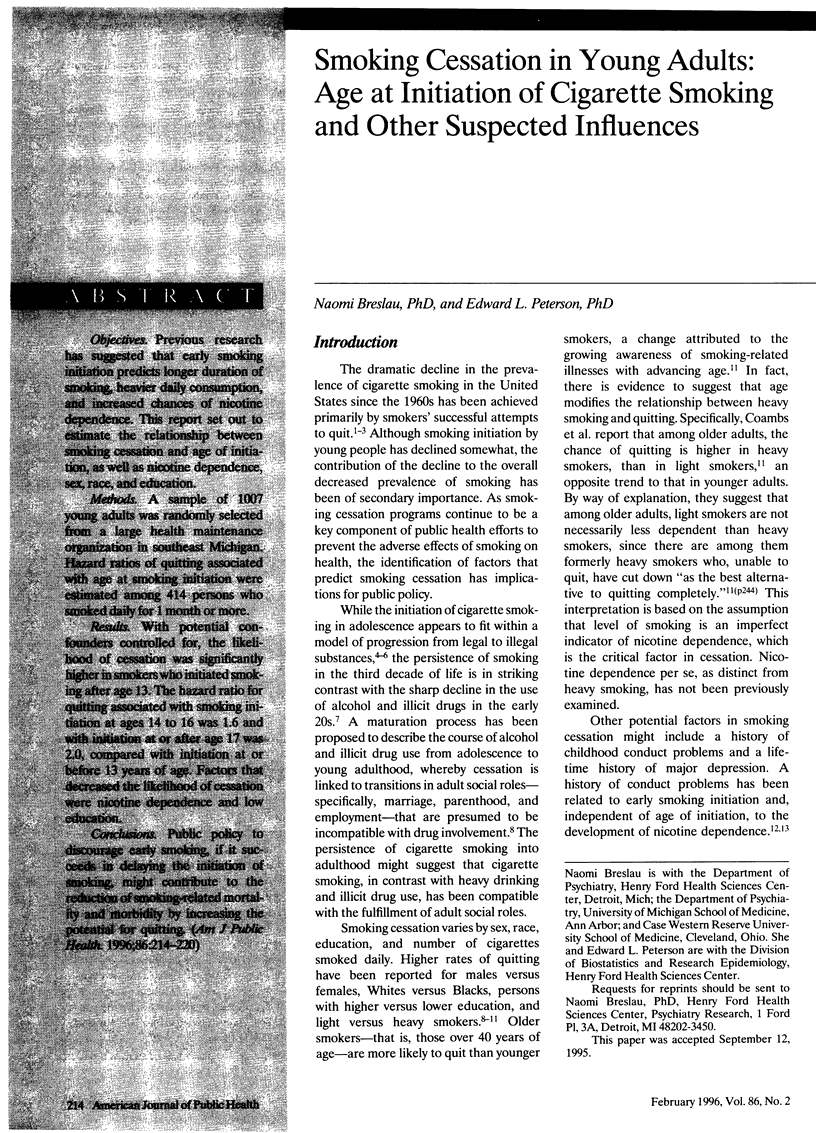

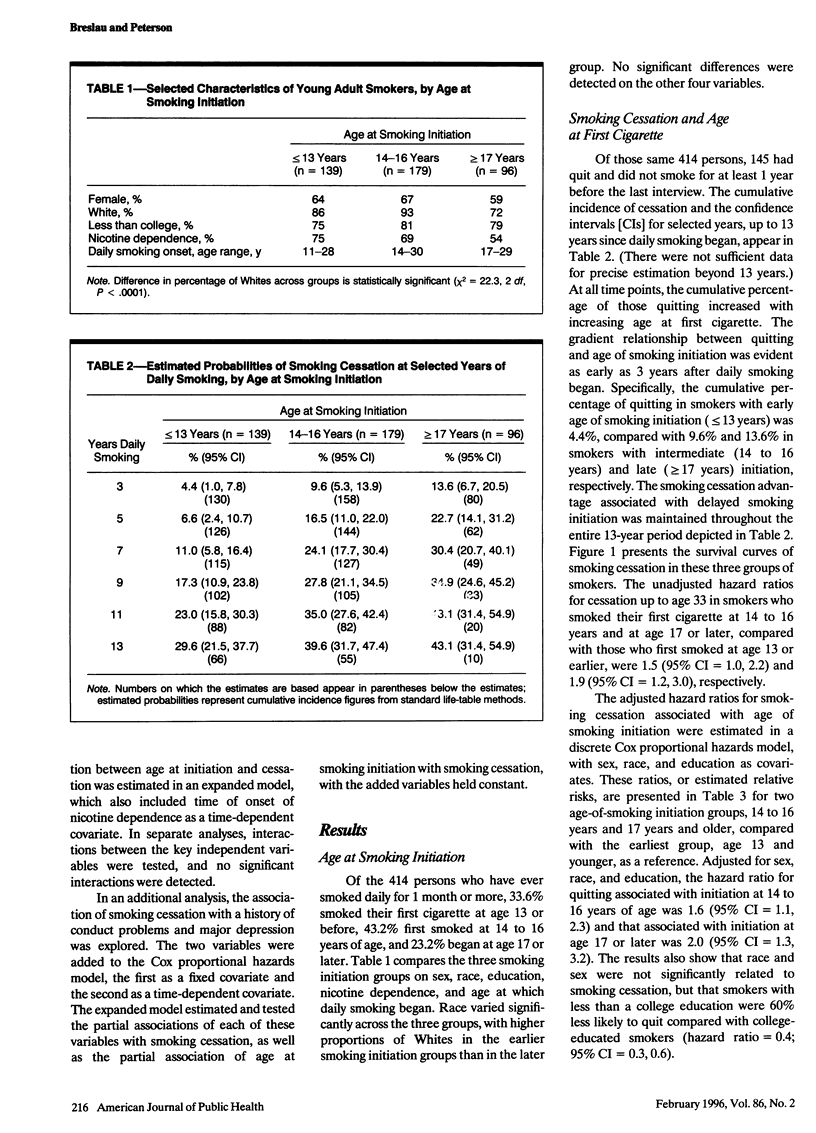

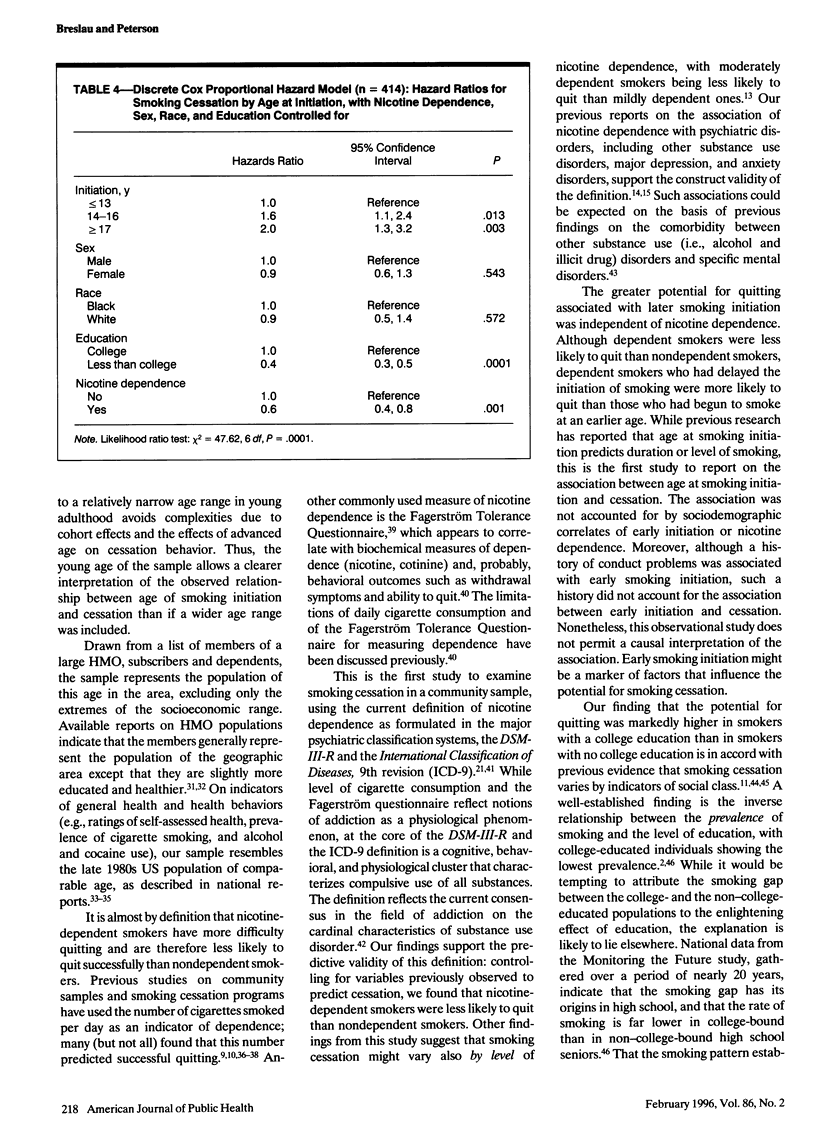
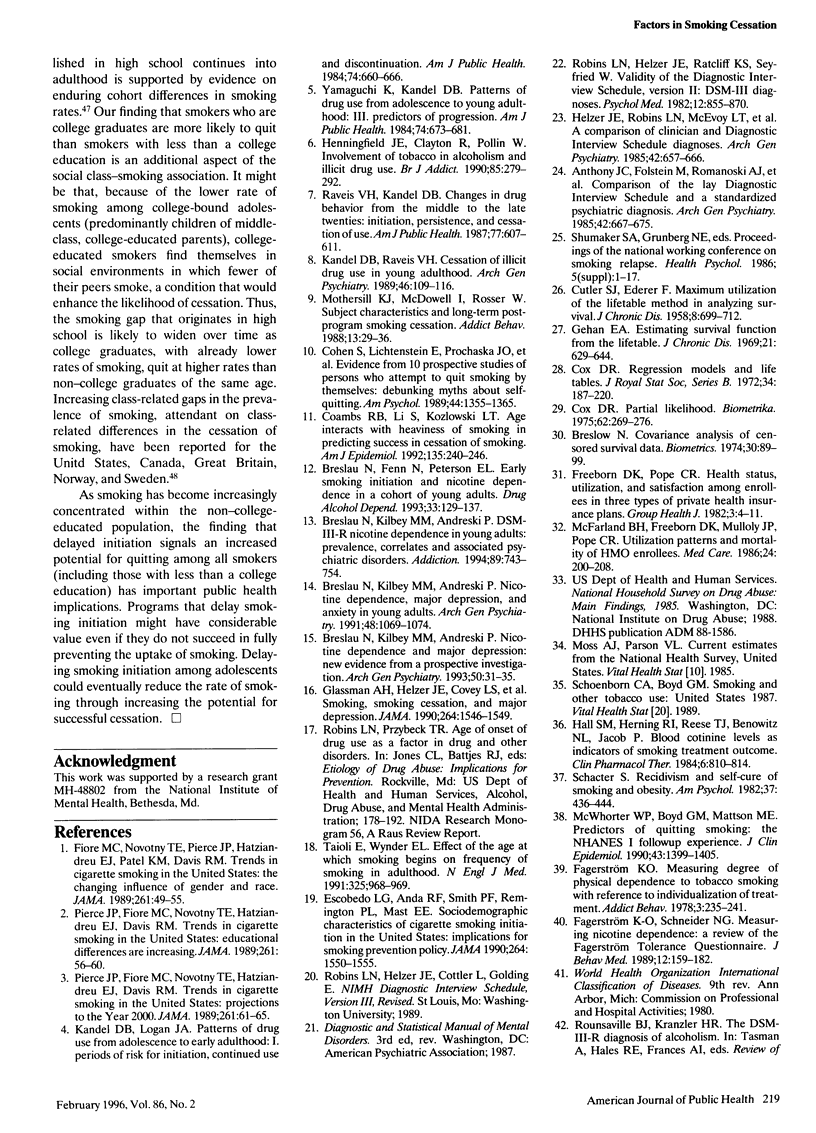
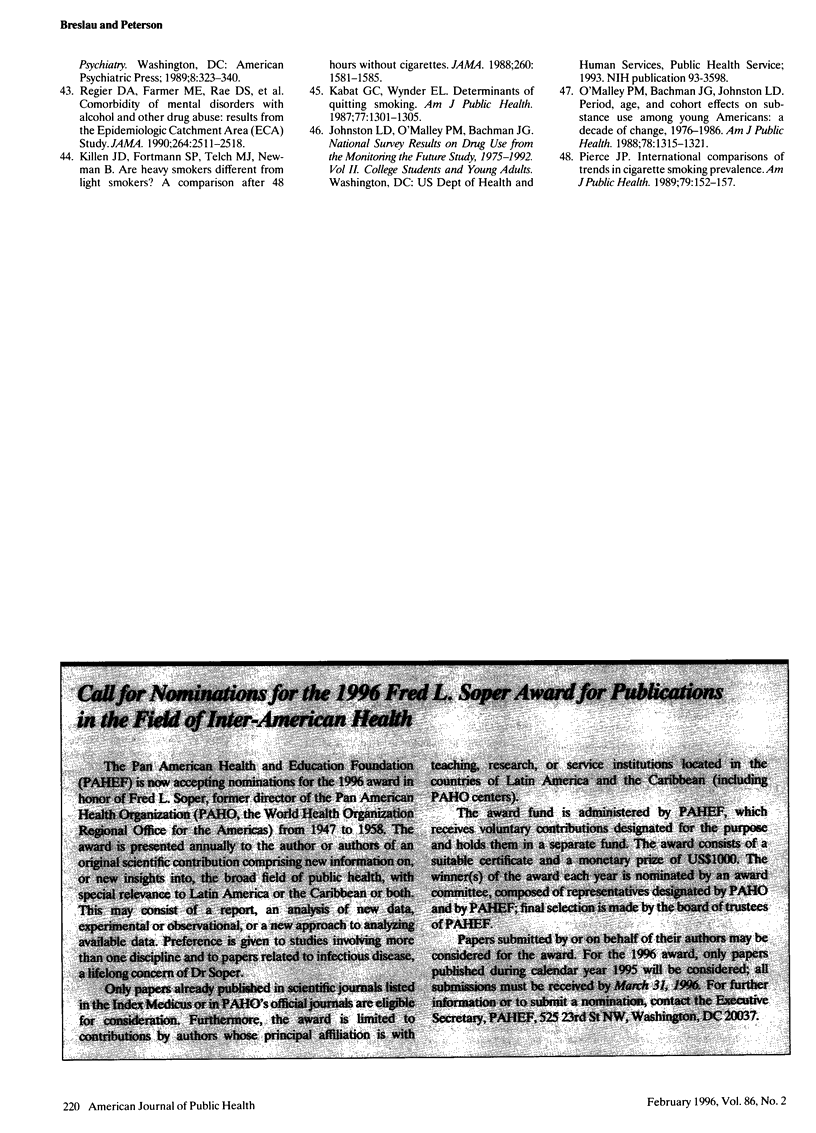
Selected References
These references are in PubMed. This may not be the complete list of references from this article.
- Anthony J. C., Folstein M., Romanoski A. J., Von Korff M. R., Nestadt G. R., Chahal R., Merchant A., Brown C. H., Shapiro S., Kramer M. Comparison of the lay Diagnostic Interview Schedule and a standardized psychiatric diagnosis. Experience in eastern Baltimore. Arch Gen Psychiatry. 1985 Jul;42(7):667–675. doi: 10.1001/archpsyc.1985.01790300029004. [DOI] [PubMed] [Google Scholar]
- Breslau N., Fenn N., Peterson E. L. Early smoking initiation and nicotine dependence in a cohort of young adults. Drug Alcohol Depend. 1993 Sep;33(2):129–137. doi: 10.1016/0376-8716(93)90054-t. [DOI] [PubMed] [Google Scholar]
- Breslau N., Kilbey M. M., Andreski P. DSM-III-R nicotine dependence in young adults: prevalence, correlates and associated psychiatric disorders. Addiction. 1994 Jun;89(6):743–754. doi: 10.1111/j.1360-0443.1994.tb00960.x. [DOI] [PubMed] [Google Scholar]
- Breslau N., Kilbey M. M., Andreski P. Nicotine dependence and major depression. New evidence from a prospective investigation. Arch Gen Psychiatry. 1993 Jan;50(1):31–35. doi: 10.1001/archpsyc.1993.01820130033006. [DOI] [PubMed] [Google Scholar]
- Breslau N., Kilbey M., Andreski P. Nicotine dependence, major depression, and anxiety in young adults. Arch Gen Psychiatry. 1991 Dec;48(12):1069–1074. doi: 10.1001/archpsyc.1991.01810360033005. [DOI] [PubMed] [Google Scholar]
- Breslow N. Covariance analysis of censored survival data. Biometrics. 1974 Mar;30(1):89–99. [PubMed] [Google Scholar]
- CUTLER S. J., EDERER F. Maximum utilization of the life table method in analyzing survival. J Chronic Dis. 1958 Dec;8(6):699–712. doi: 10.1016/0021-9681(58)90126-7. [DOI] [PubMed] [Google Scholar]
- Coambs R. B., Li S., Kozlowski L. T. Age interacts with heaviness of smoking in predicting success in cessation of smoking. Am J Epidemiol. 1992 Feb 1;135(3):240–246. doi: 10.1093/oxfordjournals.aje.a116277. [DOI] [PubMed] [Google Scholar]
- Cohen S., Lichtenstein E., Prochaska J. O., Rossi J. S., Gritz E. R., Carr C. R., Orleans C. T., Schoenbach V. J., Biener L., Abrams D. Debunking myths about self-quitting. Evidence from 10 prospective studies of persons who attempt to quit smoking by themselves. Am Psychol. 1989 Nov;44(11):1355–1365. doi: 10.1037//0003-066x.44.11.1355. [DOI] [PubMed] [Google Scholar]
- Escobedo L. G., Anda R. F., Smith P. F., Remington P. L., Mast E. E. Sociodemographic characteristics of cigarette smoking initiation in the United States. Implications for smoking prevention policy. JAMA. 1990 Sep 26;264(12):1550–1555. [PubMed] [Google Scholar]
- Fagerstrom K. O., Schneider N. G. Measuring nicotine dependence: a review of the Fagerstrom Tolerance Questionnaire. J Behav Med. 1989 Apr;12(2):159–182. doi: 10.1007/BF00846549. [DOI] [PubMed] [Google Scholar]
- Fagerström K. O. Measuring degree of physical dependence to tobacco smoking with reference to individualization of treatment. Addict Behav. 1978;3(3-4):235–241. doi: 10.1016/0306-4603(78)90024-2. [DOI] [PubMed] [Google Scholar]
- Fiore M. C., Novotny T. E., Pierce J. P., Hatziandreu E. J., Patel K. M., Davis R. M. Trends in cigarette smoking in the United States. The changing influence of gender and race. JAMA. 1989 Jan 6;261(1):49–55. [PubMed] [Google Scholar]
- Freeborn D., Pope C. Health status, utilization, and satisfaction among enrollees in three types of private health insurance plans. Group Health J. 1982 Winter;3(1):4–11. [PubMed] [Google Scholar]
- Gehan E. A. Estimating survival functions from the life table. J Chronic Dis. 1969 Feb;21(9):629–644. doi: 10.1016/0021-9681(69)90035-6. [DOI] [PubMed] [Google Scholar]
- Glassman A. H., Helzer J. E., Covey L. S., Cottler L. B., Stetner F., Tipp J. E., Johnson J. Smoking, smoking cessation, and major depression. JAMA. 1990 Sep 26;264(12):1546–1549. [PubMed] [Google Scholar]
- Hall S. M., Herning R. I., Jones R. T., Benowitz N. L., Jacob P., 3rd Blood cotinine levels as indicators of smoking treatment outcome. Clin Pharmacol Ther. 1984 Jun;35(6):810–814. doi: 10.1038/clpt.1984.117. [DOI] [PubMed] [Google Scholar]
- Helzer J. E., Robins L. N., McEvoy L. T., Spitznagel E. L., Stoltzman R. K., Farmer A., Brockington I. F. A comparison of clinical and diagnostic interview schedule diagnoses. Physician reexamination of lay-interviewed cases in the general population. Arch Gen Psychiatry. 1985 Jul;42(7):657–666. doi: 10.1001/archpsyc.1985.01790300019003. [DOI] [PubMed] [Google Scholar]
- Henningfield J. E., Clayton R., Pollin W. Involvement of tobacco in alcoholism and illicit drug use. Br J Addict. 1990 Feb;85(2):279–291. doi: 10.1111/j.1360-0443.1990.tb03084.x. [DOI] [PubMed] [Google Scholar]
- Kabat G. C., Wynder E. L. Determinants of quitting smoking. Am J Public Health. 1987 Oct;77(10):1301–1305. doi: 10.2105/ajph.77.10.1301. [DOI] [PMC free article] [PubMed] [Google Scholar]
- Kandel D. B., Logan J. A. Patterns of drug use from adolescence to young adulthood: I. Periods of risk for initiation, continued use, and discontinuation. Am J Public Health. 1984 Jul;74(7):660–666. doi: 10.2105/ajph.74.7.660. [DOI] [PMC free article] [PubMed] [Google Scholar]
- Kandel D. B., Raveis V. H. Cessation of illicit drug use in young adulthood. Arch Gen Psychiatry. 1989 Feb;46(2):109–116. doi: 10.1001/archpsyc.1989.01810020011003. [DOI] [PubMed] [Google Scholar]
- Killen J. D., Fortmann S. P., Telch M. J., Newman B. Are heavy smokers different from light smokers? A comparison after 48 hours without cigarettes. JAMA. 1988 Sep 16;260(11):1581–1585. [PubMed] [Google Scholar]
- McFarland B. H., Freeborn D. K., Mullooly J. P., Pope C. R. Utilization patterns and mortality of HMO enrollees. Med Care. 1986 Mar;24(3):200–208. doi: 10.1097/00005650-198603000-00002. [DOI] [PubMed] [Google Scholar]
- McWhorter W. P., Boyd G. M., Mattson M. E. Predictors of quitting smoking: the NHANES I followup experience. J Clin Epidemiol. 1990;43(12):1399–1405. doi: 10.1016/0895-4356(90)90108-2. [DOI] [PubMed] [Google Scholar]
- Mothersill K. J., McDowell I., Rosser W. Subject characteristics and long term post-program smoking cessation. Addict Behav. 1988;13(1):29–36. doi: 10.1016/0306-4603(88)90022-6. [DOI] [PubMed] [Google Scholar]
- O'Malley P. M., Bachman J. G., Johnston L. D. Period, age, and cohort effects on substance use among young Americans: a decade of change, 1976-86. Am J Public Health. 1988 Oct;78(10):1315–1321. doi: 10.2105/ajph.78.10.1315. [DOI] [PMC free article] [PubMed] [Google Scholar]
- Pierce J. P., Fiore M. C., Novotny T. E., Hatziandreu E. J., Davis R. M. Trends in cigarette smoking in the United States. Educational differences are increasing. JAMA. 1989 Jan 6;261(1):56–60. [PubMed] [Google Scholar]
- Pierce J. P., Fiore M. C., Novotny T. E., Hatziandreu E. J., Davis R. M. Trends in cigarette smoking in the United States. Projections to the year 2000. JAMA. 1989 Jan 6;261(1):61–65. [PubMed] [Google Scholar]
- Pierce J. P. International comparisons of trends in cigarette smoking prevalence. Am J Public Health. 1989 Feb;79(2):152–157. doi: 10.2105/ajph.79.2.152. [DOI] [PMC free article] [PubMed] [Google Scholar]
- Raveis V. H., Kandel D. B. Changes in drug behavior from the middle to the late twenties: initiation, persistence, and cessation of use. Am J Public Health. 1987 May;77(5):607–611. doi: 10.2105/ajph.77.5.607. [DOI] [PMC free article] [PubMed] [Google Scholar]
- Regier D. A., Farmer M. E., Rae D. S., Locke B. Z., Keith S. J., Judd L. L., Goodwin F. K. Comorbidity of mental disorders with alcohol and other drug abuse. Results from the Epidemiologic Catchment Area (ECA) Study. JAMA. 1990 Nov 21;264(19):2511–2518. [PubMed] [Google Scholar]
- Robins L. N., Helzer J. E., Ratcliff K. S., Seyfried W. Validity of the diagnostic interview schedule, version II: DSM-III diagnoses. Psychol Med. 1982 Nov;12(4):855–870. doi: 10.1017/s0033291700049151. [DOI] [PubMed] [Google Scholar]
- Taioli E., Wynder E. L. Effect of the age at which smoking begins on frequency of smoking in adulthood. N Engl J Med. 1991 Sep 26;325(13):968–969. doi: 10.1056/NEJM199109263251318. [DOI] [PubMed] [Google Scholar]
- Yamaguchi K., Kandel D. B. Patterns of drug use from adolescence to young adulthood: III. Predictors of progression. Am J Public Health. 1984 Jul;74(7):673–681. doi: 10.2105/ajph.74.7.673. [DOI] [PMC free article] [PubMed] [Google Scholar]


